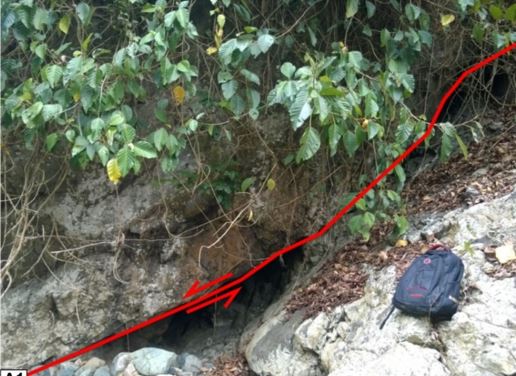Structure and Tectonic Reconstruction of Bayah Complex Area, Banten
DOI:
https://doi.org/10.24273/jgeet.2018.3.2.1554Keywords:
Structure, tectonic, orogeny, wrench fault, BayahAbstract
The research aimed to reconstruct the geological structures and tectonics of the Bayah complex area. The structures found that grouped into regional structural patterns used to determine the ages and the events that responsible to its formation. The methods used in this research include field and studio method. Field method carried out to map the outcrops and record geological structures data using geological compass, GPS, tape measurement, and geological hammer, while studio method performed to process and analyze data using software such as Win Tensor, Dips, MapInfo Professional 10.5 and CorelDraw X4. The geological structure of the Bayah has varying patterns and ages. The fracture patterns show N-S and E-W direction which is belong to Sundanese and Java Pattern formed in range of the Early Eocene to Pliocene. While the faults that have direction of SW-NE and E-W are classified into Meratus and Java Pattern. However, metamorphic rock foliations show NW-SE and N-S direction that belonging to the Pre-Tertiary Sumatra Pattern. The three faults of this research are estimated to be formed by the effect of orogenesis that occurring in different events and ages. JSA-014 fault is predicted to form due to orogeny I or orogeny II in the Early Oligocene - Middle Miocene, this fault classified as the 2nd order right lateral wrench fault. JSA-034 fault is formed by orogeny I in Early Oligocene - Middle Miocene, this fault is also classified as the 2nd order right lateral wrench fault. While JSA-080 fault has relatively young age that formed due to orogeny III in the Middle Miocene - Pliocene and belonging to the 3rd order left lateral wrench fault.
Downloads
References
Davis, G.H., Bump, A.P., Garcia, P.E., Ahlgren, S.G., 2000. Conjugate Riedel Deformation Band Shear Zone, Journal of Structure Geology, 22, pp. 169-190.
Hall, R., 1996. Reconstruction Cenozoic SE Asia; Hall, R. And Blundell, D. (eds), Tectonic Evolution of Southeast Asia. Geological Society Special Publication, 106, pp. 153-84.
Hall, R., 2002., Cenozoic Geological and Plate Tectonic Evolution of SE Asia and the SW Pacific: Computer-Based Reconstruction, Model, and Animation. Journal of Asian Earth Science, 20, pp. 353-431.
Hansen, B.P., Stone, J.R., and Lane, J.W.Jr., 1999. Characteristics of Fractures in Crytalline Bedrock Determined by Surface and Borehole Geophysical Surveys, Eastern Surplus Superfund Site, Meddybemps, Maine. Water-Resorces Investigation Report 99-4050 of U.S. Geological Survey.
Heidrick, T.L. and Aulia, K., 1993. A structural and Tectonic Model of The Coastal. Plain Block, Central Sumatera Basin, Indonesian.Proceeding of 22th Indonesian Petroleum Assosiation Annual Convention, Jakarta, pp. 285-316.
Hilmi, F. and Haryanto, I., 2008. Pola Struktur Regional Jawa Barat. Bulletin of Scientific Contribution, 6 (1), pp. 57-66.
Kulikowski, D., Amrouch, K., Barwani, M.A., Liu, W., Cooke, D., 2015. Insights Into the Tectonic Stress History and Regional 4-D Natural Fracture Distribution in the Australian Cooper Basin Using Etchecopar's Calcite Twin Stress Inversion Technique, 2-D/3-D Seismic Interpretation and Natural Fracture Data From Image Logs and Core, AAPG/SEG International Conference & Exhibition, Melbourne, Australia, paper #41752.
Moody, J.D., Hill, M.J., 1956. Wrench-Fault Tectonics, Bulletin of the Geology Society of America, 67, pp. 1207-1246.
Pulunggono, A. and Martodjodjo, S., 1994. Perubahan Tektonik Paleogen dan Neogen Merupakan Peristiwa Tektonik Terpenting di Jawa. Proceeding on Geology and Geotechnic Java Island since Late Mesozoic to Quaternary, pp. 37-50.
Ragan, D.M., 2009. Structural Geology: an Introduction to Geometrical Techniques, 4th Edition. Cambridge University Press, Cambridge.
Sribudiyani, Muchsin, N., Ryacudu, R., Kunto, T., Astono, P., Prasetya, I., Sapiie, B., Asikin, S., Harsolumakso, A.H., and Yulianto, I., 2003. The Collision of the East Java Microplate and Its Implication for Hydrocarbon Occurrences in the East Java Basin. Proceeding of 29th Indonesian Petroleum Association Annual Convention.
Sujatmiko and Santoso, S., 1992. Peta Geologi Regional Lembar Leuwidamar. Pusat Penelitian dan Pengembangan Geologi, Bandung.
Sukarna, D., Mangga, S.A., and Brata, K., 1993. Geology of the Bayah Area: Implication for the Cenozoic Evolution of West Java, Indonesa. Geology Society of Malaysia, 33, pp. 163-180.
Van Bemmelen, R.W., 1949. The Geology of Indonesia. Martinus Nijhoff, Den Haag.

Downloads
Published
Issue
Section
License
Copyright @2019. This is an open-access article distributed under the terms of the Creative Commons Attribution-ShareAlike 4.0 International License which permits unrestricted use, distribution, and reproduction in any medium. Copyrights of all materials published in JGEET are freely available without charge to users or / institution. Users are allowed to read, download, copy, distribute, search, or link to full-text articles in this journal without asking by giving appropriate credit, provide a link to the license, and indicate if changes were made. All of the remix, transform, or build upon the material must distribute the contributions under the same license as the original.










